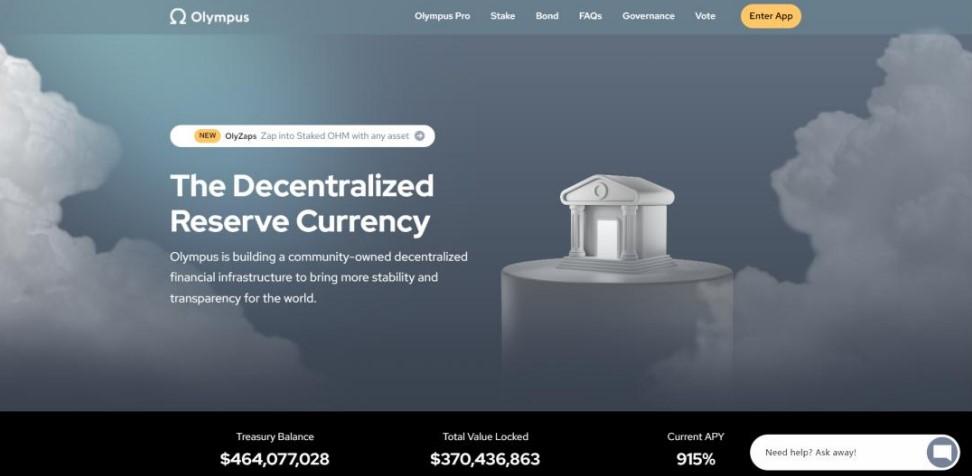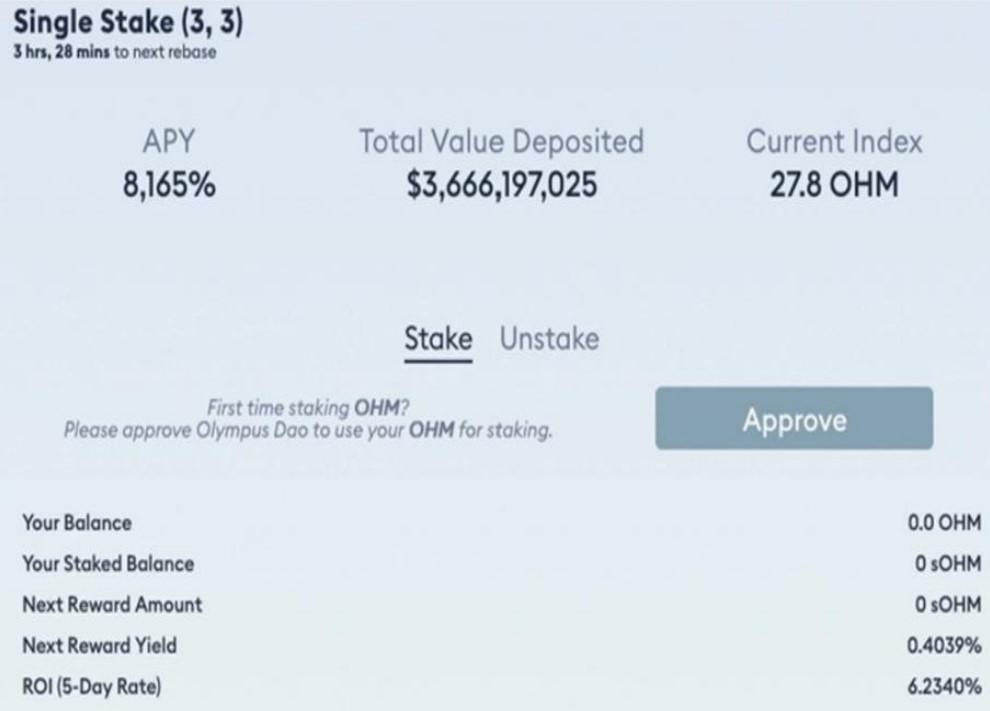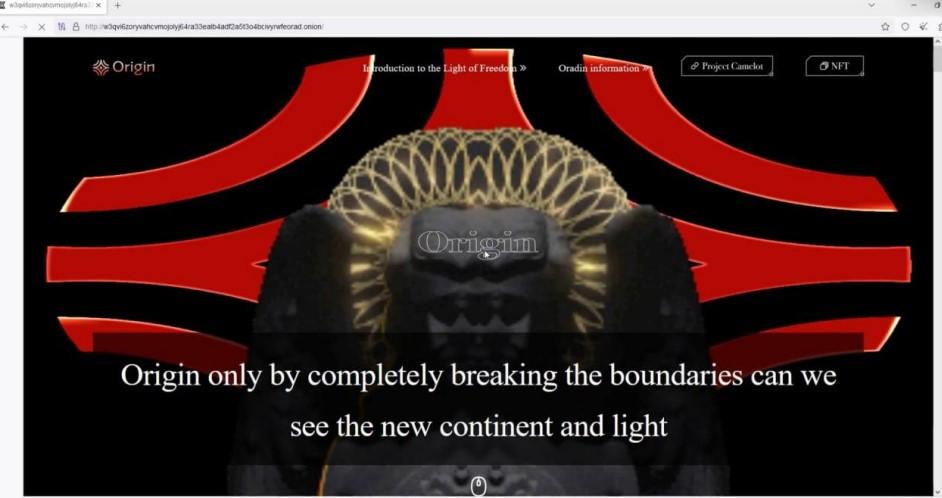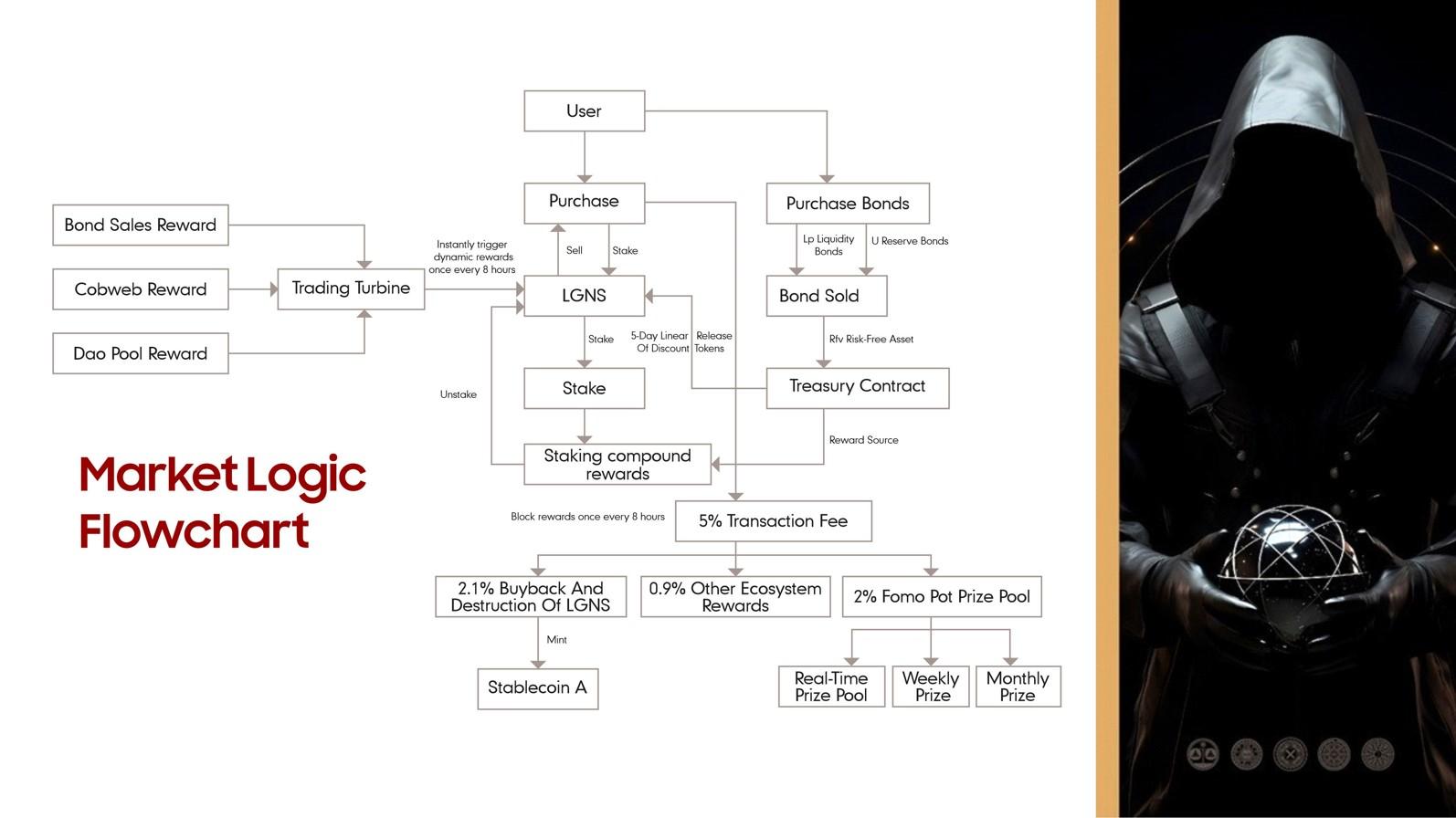Source: Metanews
In the entire field of blockchain, the pace of the DeFi track has always been fast. The strong liquidity advantage and massive traffic make DeFi's self-iteration particularly prominent. As we all know, DeFi 1.0 focuses on the short-term incentive model of liquidity mining. Drawing on the worldview of traditional financial markets, DeFi 1.0 has respectively realized Central banks in the decentralized financial world (such as MakerDAO), Commercial banking sectors (such as money markets Aave and Compound), Non-bank financial institutions (such as trading platform Uniswap, aggregator Yearn. finance).
Looking back to 2021, it was the era of global masks, and our team obtained information about OlympusDAO in late February. After two weeks of in-depth research and judgment, we formulated an investment decision and plan. At the beginning of the project, we started from the whitelist to build positions in the secondary market, investing a total of 150,000 DAI, and the average OHM position price was $20.6. Our shipment price for OHM started selling above $800, and we eventually achieved a profit of nearly 50 times. Therefore, whenever we find similar projects, our team will be full of enthusiasm and even excitement.

First, let us sort out the relevant mechanisms of Olympus DAO to understand its economic structure and operating logic better.
Drawing on the worldview of traditional financial markets, DeFi 1.0 has achieved:
-
The central bank of the decentralized finance world (such as MakerDAO)
-
Commercial banking sector (e.g., money market Aave and Compound)
-
Non-bank financial institutions (such as trading platform Uniswap, aggregator Yearn.finance)
Representative projects include MakerDAO, Compound, Aave, Uniswap, Sushiswap, and yearn.finance. But the drawbacks of 1.0 are also prominent. Short-term incentives have led some liquidity providers to over-exploit projects and protocols and even accelerated the demise of projects.
Since then, the development of DeFi has been unfolding in two directions:
-
Release credit potential
-
Improve the efficiency of capital utilization. In this context, the concept of DeFi 2.0 came out.
DeFi 2.0 changes the relationship between protocols and liquidity providers through new mechanisms, ultimately redeveloping the liquidity service. Among them is this representative project: OlympusDAO
Preface
OHM, the native token of the Olympus Protocol, a decentralized finance (DeFi) system, started at an opening price of $4 and quickly rose to nearly $1,300, with a total market cap of $4.3 billion. Although more than two years have passed, OHM's market value has dropped from US$4.3 billion to US$189 million, and OHM's price has also dropped to about US$12. Olympus also has a brilliant record. Next, I will summarize and analyze the narrative of OlympusDAO.

Introduction to the non-stable currency mechanism of the Olympus algorithm:
OHM, the native token of the Olympus protocol, aims to become a reserve currency with stable value. Still, it is defined as an algorithmically non-stable coin. It means that the price of OHM will not be forced to remain at the equivalent of $1 but will adjust based on market supply and demand and the protocol mechanism. It allows the price of OHM to float freely without being restricted by a hard peg.
OHM is different from the algorithmic stablecoin LUNA. In contrast, the Luna token is defined as an algorithmic stablecoin, and there is a 1:1 complicated anchoring agreement between LUNA and UST. No matter what the market price of LUNA is, it is underpinned by a rugged anchor of 1UST. The annualized return rate of UST is only about 20%. The stern anchor agreement leads to a death spiral in LUNA. Everyone knows the story behind it. LUNA has a market value of US$40 billion. It returned to zero within two days, single-handedly destroying the entire industry and starting a prolonged bear market in the currency circle.
Compared with algorithmic stablecoins (such as stablecoin), whose purpose is to control the price at USD 1, or stablecoins directly anchored to the US dollar (such as USDT/USDC), the stability mechanism of the Olympus protocol is that only 1 OHM is promised. 1 DAI serves as reserve support; therefore, the price of OHM can fluctuate freely without being restricted by the 1 USD anchor.
The economic structure and operating logic of the Olympus protocol rely on three pillars:
Reserve Pillar Builds Purchasing Power
Liquidity Pillar Promotes Accessibility
Utility pillar improves usability.
Reserve pillar (Bonding): The reserve pillar increases OHM's treasury reserve assets through user asset locking, thereby supporting the value of OHM. Users associate specific assets with the Olympus protocol, which are locked in the protocol as a reserve of risk-free value assets. In return, users will receive OHM tokens, and Bonding will mint OHM at a price lower than the market price based on the supply and demand algorithm. This process is similar to ultra-short-term zero-coupon bonds. The agreement linearly releases OHM to OHM within a 5-day exercise period.
Staking and Rebase
The rebase mechanism is designed to adjust the token value by automatically increasing or decreasing the supply, theoretically achieving stability. When used in conjunction with Staking, rebase rewards are usually distributed to staking users, and even if the total supply of tokens increases, the supply in circulation may remain the same because these new supplies are mainly distributed to staking users.
For Olympus, stakers stake their OHM in the protocol, obtain ohm, and obtain so-called "rebase rewards" through Staking. If the market value of OHM is higher than the target value, the rebase mechanism will increase the number of OHM and transfer these increased OHM distributed to Staking participants. The APY of these rewards will once reach more than 8165%. The source of these rewards is inseparable from Bonding.

Project Analysis: The highlights of the Olympus protocol’s operating mechanism are summarized as follows:
Why can OHM's unit price, backed by only 1 DAI, rise to more than $1,300?
Protocol-controlled liquidity replaces liquidity mining: users purchase OHM from the protocol at a discount by trading with LP Token or other single-currency assets such as DAI, wETH, etc. This process is called Bonding, and the former is called They are liquidity bonds, called reserve bonds. Bonding is a crucial implementation method for the OlympusDAO protocol to own and control liquidity.
Unnatural arbitrage mechanism: Olympus has created an unnatural risk-free arbitrage mechanism, which mints OHM at a price lower than the market price through the Bonding sales process, encouraging users to purchase discount bonds. This mechanism helps attract significant capital participation, provides the protocol with an initial funding boost, and eliminates the risks that third-party liquidity providers may pose.
Staking and Rebase: Olympus adopts the Staking and Rebase mechanism. The ultra-high APY rewards obtained through Staking attract more users to participate in the protocol. The rebase mechanism increases or decreases the supply of OHM according to market demand, thus affecting the price of OHM. This mechanism effectively encourages users to stake and hold OHM.
Nash Equilibrium (3/3) Game Theory: In the OlympusDAO protocol, the three behaviors of users and the resulting benefits:
STAKE (+2) Bonding (+1) Sell (-2) Both STAKE and Bonding have a positive effect on the agreement, while Sell is not beneficial; both Stake and Sell have a direct impact on the price of OHM, but Bonding does not. Olympus uses a (3/3) game theory strategy for marketing, making staking a natural choice and attracting more investors to participate. It further increases the demand for OHM, driving up its price.

After analyzing the Olympus mechanism, the "protagonist" I want to introduce today is named ORIGIN.
There are two different theories about the ORIGIN of this project. One theory is that it comes from the dark web, and the identity of the project party has yet to be discovered. Another way to say it is that it is a product developed by the Olympus technical team. No matter which version, we verified the dark web information through relevant channels and confirmed this statement. However, we need help verifying whether the technical team originated from the Olympus technical team.
According to industry experience, projects released on the dark web usually have outstanding performance in the industry. But in any case, excellent projects ultimately require a complete economic model and operational structure to support them. So, what is the story of ORIGIN? Let’s break it down in detail.
Introduction to ORIGIN algorithm non-stable currency:
ORIGIN is a DeFi 3.0 protocol based on the algorithmic non-stable currency LGNS. Its main goal is to build the world's first private and anonymous stablecoin payment ecosystem and to set a global financial benchmark to guide future financial development. Here are some key takeaways:
Privacy Anonymous Stablecoins: ORIGIN aims to enable stable and predictable currency issuance, enabling individuals to issue algorithmically non-stablecoins and mint these algorithmically non-stablecoins into privacy-anonymous stablecoins. It means users can create and use private stablecoins.
Everyone is an issuer: ORIGIN proposes the concept of "everyone is an issuer," which means that individuals can issue their anonymous stablecoins rather than just being issued by central banks or other financial institutions.

Be able to participate in and control the currency issuance process while maintaining the currency's stability.
Similarities between the underlying operating logic of ORIGIN (ORIGIN) and Olympus
LGNS is ORIGIN’s native token and a free-floating currency backed by specific mainstream crypto assets. Known as an “unstable” algorithmic stablecoin, users can obtain LGNS through two channels:
1. Secondary market purchase: purchase LGNS on decentralized exchanges;
2. Purchase on ORIGIN protocol Bonding (equivalent to the primary market). Bonding can be divided into two types:
Reserve bonds
Liquidity bonds
The ORIGIN protocol allows users to deposit specific mainstream crypto assets in exchange for LGNS at a discounted price, which will be linearly released to the account within five days.
Debt supply mechanism:
Regulated through bond supply mechanism: The supply of LGNS is regulated based on reserve assets. For every LGNS minted by the protocol, 1 USDT will be used to support its value. When the price of LGNS is less than $ 1 USDT, the protocol will use reserve assets to buy back LGNS and destroy them until the price exceeds $1 USDT. The price of LGNS has no upper limit and can theoretically be infinitely more significant than $1 USDT.
Stake:
Users stake LGNS and receive LGNS rewards every 8 hours, earning three times their income in 24 hours. The annualized income of currency-based compound interest is as high as 79 times.

How the ORIGIN economic model differs from Olympus DAO:
1. Solutions to ultra-high APY and sell-off problems:
Both OlympusDAO and ORIGIN protocols face the challenge of how to deal with ultra-high APY (Annualized Percentage Yield) and sell-offs. Still, they have adopted different approaches to deal with this problem.
OlympusDAO protocol solution:
The core idea of OlympusDAO After the price of OHM fell back to around 1DAI, the protocol made a repurchase intervention to ensure its stability as a reserve asset. However, the reality is that the price of OHM often has difficulty reaching 1DAI, so this mechanism mainly plays a conceptual role in supporting the price rather than actual action.
ORIGIN protocol solution:
The ORIGIN protocol employs three intervention mechanisms to prevent significant price drops in tokens, specifically:
1. Treasury Reserve Agreement Repurchase Mechanism: The ORIGIN protocol uses USDT as a reserve. When the LGNS token price is higher than 1 USDT, the agreement mints and sells new LGNS; when the LGNS price is lower than 1 USDT, the agreement purchases LGNS from the market. Destroy the non-stablecoin LGNS tokens and mint anonymous stablecoin A.
2. Circuit breaker protection mechanism: If the price of the ORIGIN token drops by more than 50% in the price of LGNS in a single trading day, the protocol will activate the repurchase mechanism, destroy the non-stable currency LGNS tokens, and mint the anonymous stablecoin A.
3. Supply and demand mechanism: The ORIGIN protocol promotes the ecosystem development of anonymous payment and anonymous transaction scenarios, which means that the demand for anonymous stable currency A increases. Among them, 70% of the revenue of the ORIGIN platform is planned to be used to repurchase LGNS tokens, destroy unstable Coin LGNS tokens, and mint anonymous stablecoin A.
All three are ways ORIGIN has responded to the sell-off, but they employ different mechanisms. OlympusDAO relies on the market's self-regulation, while the ORIGIN protocol intervenes in the market through buyback and destruction to maintain the stability of token prices.
2. Different concepts of consensus mechanism setting:
Olympus DAO seems focused on its (3/3) consensus mechanism but lacks a community promotion mechanism. Not as strong as a community
Consensus support will make it difficult for the protocol to maintain long-term market momentum.
Based on the (3/3) consensus mechanism of Olympus DAO, the ORIGIN protocol has created a series of innovative methods to solve early community consensus issues and enhance community cohesion and user participation. The following are some of the methods and mechanisms adopted by the ORIGIN protocol:
Bond sales incentives: The ORIGIN protocol establishes a bond sales incentive mechanism.
Spider web system rewards: The spider web system is part of the ORIGIN protocol. It provides a reward mechanism to encourage users to participate actively in different levels and roles in the protocol.
DAO Pool Rewards: The ORIGIN protocol also sets up DAO pool rewards, which means users can earn rewards by participating in the protocol’s governance process.
More ways to play: The ORIGIN protocol provides the above incentive mechanism and adds more ways to play, such as the FOMO POT lottery and transaction turbine mechanism. These additional functions can attract more users to participate, improving the protocol's transaction activity and community user stickiness.
3. Different concepts of deflation mechanism
The operating mechanism of Olympus DAO seems to include only infinite inflation and infinite minting of OHM without setting up a deflation mechanism. This could be a fatal bug in the mechanism, as there is no cap on OHM supply, and inflation could negatively impact the stability of the protocol.
The deflation mechanism of the ORIGIN protocol is an innovative solution. The following are the main features and operation methods of the deflation mechanism of the ORIGIN protocol: The ORIGIN protocol introduces two tokens, namely the algorithmic non-stable currency LGNS and the privacy anonymous stable currency A.
Users can use the algorithmic non-stable currency LGNS to mint the privacy anonymous stable currency A. The minted LGNS will be injected into the black hole and destroyed. The increase in demand will lead to a rise in deflation and destruction, thus increasing the scarcity of the token.
4. Differences in ecosystem strategic development ideas
At present, the ecosystem development of Olympus DAO seems to be relatively simple, mainly relying on the profitability of the credit business sector. The lack of a diverse ecosystem will make the protocol more fragile, and the three pillars that support the Olympus architecture (the practicality pillar to improve usability) are missing.
At present, the ORIGIN ecosystem plan is quite ambitious. It would be great if 50% of it is implemented. The details are as follows:
The ORIGIN1.0 stage uses the algorithmic non-stable currency LGNS as the traffic entrance to activate the traffic gathering place of the entire ecosystem and create the cornerstone of the global decentralized financial ecosystem, which will serve as the basis for subsequent privacy public chains/cross-chain transactions/decentralized exchanges/lending protocols. /Gateway Protocol/WB3 Social/Metaverse Finance is paving the way for extension. From this point of view, ORIGIN starts from the bottom consensus, upper application layer, ecosystem layer, and other components. It carries out a new transformation for each key layer of decentralized finance, creating an all-around, multi-level, interconnected Web3 digital financial metaverse system.
Project Analysis: Summary
Overall, both ORIGIN and OlympusDAO have unique innovations in the DeFi field. ORIGIN has built a diversified financial ecosystem based on OlympusDAO and opened up a new field of privacy stablecoins, attracting widespread attention. In contrast, OlympusDAO supports the development of decentralized banks by innovating the POL protocol.
Finally, we believe the stablecoin space is challenging, but ORIGIN and OlympusDAO have proposed excellent concepts. We salute the developers of OlympusDAO and admire ORIGIN’s privacy-anonymous stablecoin concept. ORIGIN is bravely implementing innovations that many want to do but are afraid to try.
Related posts
2024-02-23
10 mins read
10779 Views
Web3 is another evolution of the current Internet, and it has also brought many changes and influences. As an important role in Web3,
2024-02-23 10 mins read 10779 Views
Web3 is another evolution of the current Internet, and it has also brought many changes and influences. As an important role in Web3,
2024-02-23 10 mins read 10779 Views
Web3 is another evolution of the current Internet, and it has also brought many changes and influences. As an important role in Web3,








